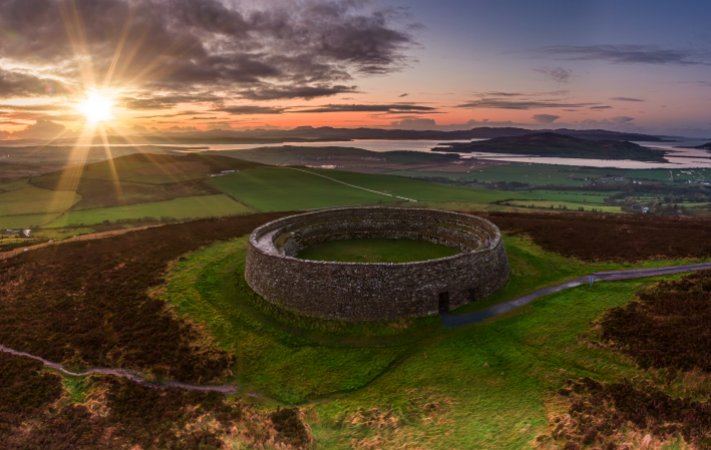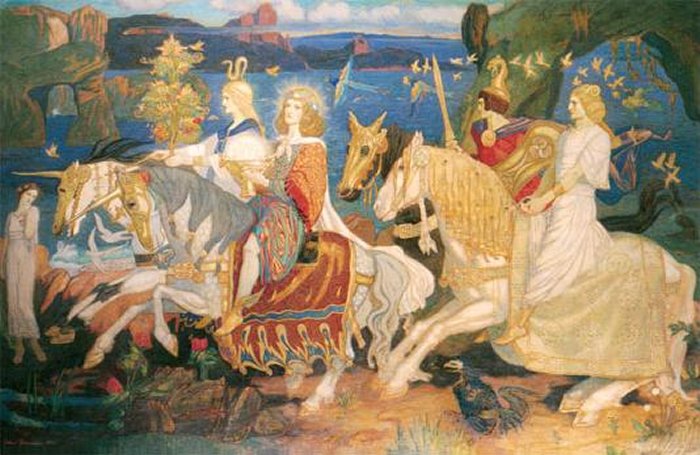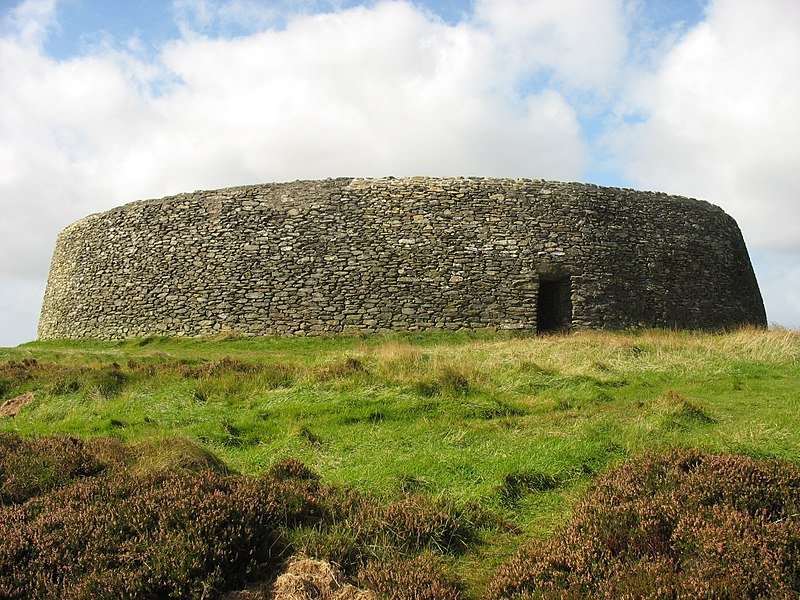Ellen Lloyd – AncientPages.com – Destroyed by King Murdoch O’Brien of Munster in 1101, the little-known stone ringfort Grianán Of Aileach was once home to the Kingdom of Ailech. Situated on top of Greenan Mountain at Inishowen in County Donegal, Ireland, the ancient site is rich in history, mythology, and folklore.
The Site’s Name Aileach Has Created Some Confusion
Grianán Of Aileach was built by the Northern Uí Néill, in the sixth or seventh century, but the site’s name has changed over the course of history.

Legend tells powerful King and God Dagda of the Tuatha De Danann built Grianán of Aileach. Credit: Adobe Stock – Lukᴀssek
Historians say, “the monument is usually, though not necessarily correctly identified as “Ailech”, capital of the Cenél Eogain from around the 6th century AD until its demolition in 1101. “ 1
Researchers have discovered there is “something of a problem with this identification. In ancient times, the name Ailech, in this Domegal connection, was used in a variety of ways as the name of both a specific place and also as the name of a number of larger kingdoms. An additional complication is that some commentators have suggested that the specific location of Ailech was not the site of the Grianán but a nearby place, now mainly in Co. Derry, known by the townland names of Elaghmore and Elaghbeg.” 1
In the Irish Law of Kingship, James Hogan clears up the confusion ᴀssociated with the name of the ancient Irish hillfort. Hogan explains that “the new kingdom and its dependencies was known as in Fochla or in Tuaiscert – both terms meaning the North.
From about 780 on, a much commoner name for the kingdom of the Northern Uí Néill is that of Ailech, derived from the prehistoric stone fortress of this name situated near the present town of Derry, in the peninsula of Inis Eoghain. However, Ailech had not been the seat of the kings of the Northern Uí Néill.
Before the eighth century, it had been simply the headquarters of the sub-kingdom of Cenél Eoghain, and it was not until the close of the eighth century when the Cenél Eoghain became the dominant dynasty of the Northern Uí Néill, that their sub-kingdom developed into the over-kingdom of Ailech.” 2
Celtic God Dagda Constructed Grianán Of Aileach Where An Irish King Was Caught Sleeping
Grianán Of Aileach is an Irish National Monument today, but locals have long feared and respected the ancient site. It was believed that anyone who entered within the fort’s walls should be careful because the site had magical powers. If one told a secret within the fort’s walls, soon, everyone would find out. Putting supersтιтion aside and recalling legends ᴀssociated with Grianán Of Aileach we find the fort has a connection with legendary Tuatha De Danann, a mythical race of God-like beings with supernatural abilities in Celtic mythology.
“Tuatha De Danann is said to have come to Ireland from the north of Europe, where they had spent many years learning arts and magic. They are represented as large, strong, and beautiful beings that mingled with mortals and yet remained superior to them.
They were believed to be a race of gods or demigods with supernatural powers, human traits and personalities, and a large variety of skills in art, crafts, music, language, love, and war. There were also Druids among these people.” 3

The Tuatha Dé Danann as depicted in John Duncan’s “Riders of the Sidhe” (1911) via wikipedia
Legend has it God Dagda, a powerful leader of Tuatha De Danann, built Grianán Of Aileach. “The Dagda was called Eochaid Ollathair the “All-Father,” not because he was the father of all the people, but rather because he acted as a father, a protector of all. It is tempting to compare him to the Norse god Odin, but the Dagda is more like warrior Thor, the Thunderer, with his mighty weapon.” 4
God Dagda and Tuatha De Danann were fighting their enemies, the Fomorians. Unfortunately, Dagda’s son Aedh was killed through jealousy by Corrgenn, a Connacht chieftain, and the ancient fort was erected around the son’s grave.
A place like Grianán Of Aileach is bound to be rich in history and mythology, and there are many interesting stories about kings who once dwelled within the walls of this historic fort. One of them was Muirchterach or “Murty of the Leather Cloaks as he is sometimes called in English. Muirchterach was an important historical figure whose son “Domhnall O Neill, the first of that illustrious name, was the immediate predecessor of Maelsheachlann Mór, who Brian Boru deposed 12 years before the battle of Clontarf.
During Muirchterach’s time the Danes were still a menace in the land, though the Irish, through the exertions of a number of valiant princes, were now beginning to get the upper hand. Muirchterach was one of these princes. Five times between 921 and 933 he fought and defeated the Danes.

The impressive ancient fort has been restored as is today an Irish National Monument. Credit: Silyba – CC BY-SA 4.0
In 939 he was caught napping: his palace at Aileach was stormed by surprise, he was made prisoner, and carried off to the Danish fleet in Lough Swille. Aielach was dangerously near the Swilly. However, he was ransomed or else managed to escape, and two years later he made a naval raid on the Hebrides and returned in triumph carrying much booty. This was a rare and dangerous adventure for an Irish King at a time when the Danish fleets swept all the northern seas.” 5
Owned today by the Irish government, the 77 feet wide fort is believed to once have been 8 feet tall. While excavating at Grianán Of Aileach, scientists found remains of an early Christian church, ancient coins, pottery, and even a board game. Outside the hillfort, there are visible remains of a well and a tumulus.
Though little known to many, Grianán Of Aileach is a remarkable ancient site that provides insight into Ireland’s rich history.
Updated on November 7, 2022
Written by Ellen Lloyd – AncientPages.com
Copyright © AncientPages.com All rights reserved. This material may not be published, broadcast, rewritten or redistributed in whole or part without the express written permission of AncientPages.com
Expand for references
- Lacey, Brian. “The Grianán of Aileach: A Note on Its Identification.” The Journal of the Royal Society of Antiquaries of Ireland131 (2001)
- Hoogan J. – Irish Law of Kingship, 1932
- Sutherland – Tuatha De Danann: Mythical Race Of God-Like Beings With Supernatural Abilities In Celtic Mythology, AncientPages.com
- Thalia Lightbringer – God Dagda – A Powerful Leader Of The Tuatha De Danann In Celtic Mythology, AncientPages.com
- Morris, Henry. “The Circuit of Ireland. By Muirchertach Na GCochall GCroiceann A.D. 941.” The Journal of the Royal Society of Antiquaries of Ireland, Seventh Series, 6, no. 1 (1936): 9-31.





